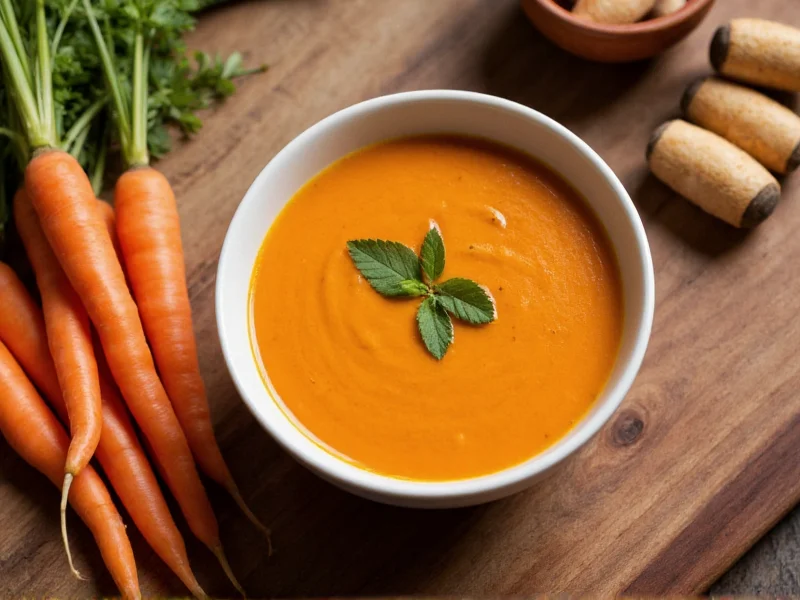Carrot soup has been a kitchen staple across cultures for centuries, evolving from simple peasant fare to a sophisticated dish featured in fine dining establishments. This humble soup transforms ordinary ingredients into a velvety, nutrient-rich meal that's both comforting and health-promoting. Understanding the proper technique and ingredient combinations separates an average carrot soup from an exceptional one that delights the palate while delivering significant nutritional benefits.
The Essential Carrot Soup Foundation
Every remarkable carrot soup begins with quality ingredients and proper technique. While recipes vary by region and personal preference, the foundational elements remain consistent across most traditional preparations. Fresh carrots form the backbone of the soup, providing natural sweetness and vibrant color. When selecting carrots for soup, choose firm, deeply colored specimens with smooth skin. Organic carrots often yield superior flavor, though thoroughly washed conventional carrots work well too.
The cooking process typically involves sautéing aromatics like onions or leeks in olive oil or butter before adding chopped carrots and liquid. Vegetable broth creates the cleanest flavor profile, though chicken broth adds richness for non-vegetarian versions. The soup simmers until carrots become fork-tender, then gets blended to a smooth consistency. This basic preparation yields a canvas perfect for numerous flavor variations that address the \"and\" in \"soup carrot and\" queries.
Popular Carrot Soup Variations
Culinary traditions worldwide have developed distinctive takes on carrot soup, each highlighting different complementary ingredients that answer what \"soup carrot and\" typically refers to in search queries.
| Variation | Key Ingredients | Origin | Distinctive Flavor Profile |
|---|---|---|---|
| Carrot and Ginger Soup | Carrots, fresh ginger, onion, vegetable broth | Global (popularized in Western cuisine) | Warm, slightly spicy with bright citrus notes |
| Carrot and Celery Soup | Carrots, celery, leeks, thyme | French | Earthy, herbal with subtle bitterness |
| Carrot and Sweet Potato Soup | Carrots, sweet potatoes, coconut milk | African/Caribbean fusion | Creamy, naturally sweet with tropical notes |
| Carrot and Orange Soup | Carrots, orange juice, cumin, coriander | Middle Eastern influence | Citrusy, aromatic with warm spice notes |
Carrot and Ginger Soup: The Most Searched Variation
When users search for \"soup carrot and\", carrot and ginger soup represents the most frequent interpretation. This combination creates a harmonious balance where the natural sweetness of carrots meets the warm, slightly spicy notes of fresh ginger. The ginger doesn't overpower but rather enhances the carrots' flavor while adding digestive benefits. Professional chefs recommend using young ginger for its milder flavor, adding it midway through cooking to preserve its bright character. Many authentic recipes include a touch of orange zest or juice to lift the flavors and create a more complex profile that keeps diners reaching for another spoonful.
Carrot and Celery Soup: The French Classic
This elegant variation showcases the culinary principle of mirepoix - the French flavor base of onions, carrots, and celery. When carrots take center stage with celery playing a supporting role, the result is a sophisticated soup with earthy depth. The celery contributes subtle herbal notes and a hint of bitterness that balances the carrots' sweetness. For the best results, use leafy celery varieties and include some of the greens for added flavor complexity. This soup pairs beautifully with crusty bread and represents what many professional chefs consider the most \"authentic\" interpretation of traditional European carrot soup.
Mastering Carrot Soup Technique
Creating exceptional carrot soup involves more than simply combining ingredients. Certain techniques elevate this simple dish to restaurant quality. Roasting carrots before soup preparation deepens their natural sweetness through caramelization, creating a more complex flavor base. When boiling, maintain a gentle simmer rather than a rolling boil to preserve delicate flavors. For perfectly smooth texture without a blender, try passing the cooked soup through a food mill.
Seasoning requires particular attention - carrots need proper salt balance to shine, and a small amount of acid (like lemon juice or vinegar) added at the end brightens the entire flavor profile. Many home cooks under-season carrot soup, resulting in a bland final product. Professional chefs recommend seasoning in layers: a pinch when sautéing aromatics, more when adding liquid, and final adjustments after blending.
Nutritional Benefits of Carrot Soup
Carrot soup delivers impressive nutritional value beyond its delightful flavor. Carrots are rich in beta-carotene, which the body converts to vitamin A - essential for vision, immune function, and skin health. One cup of carrot soup typically provides over 300% of the daily recommended vitamin A intake. The addition of healthy fats like olive oil or coconut milk enhances absorption of these fat-soluble vitamins.
Ginger, a common addition in many \"soup carrot and\" variations, offers anti-inflammatory properties and aids digestion. When preparing carrot and ginger soup, the combination creates a synergistic effect where the nutritional benefits of both ingredients are amplified. For those seeking low-calorie comfort food, carrot soup typically ranges from 100-150 calories per serving while providing substantial fiber content that promotes satiety.
Storage and Reheating Best Practices
Proper storage extends the life of homemade carrot soup while maintaining quality. Cool soup completely before transferring to airtight containers, leaving one inch of headspace for expansion if freezing. Refrigerated carrot soup stays fresh for 4-5 days, while frozen soup maintains quality for 4-6 months. When reheating, do so gradually over medium-low heat to prevent separation or scorching. For cream-based variations, stir frequently during reheating. Adding a splash of fresh broth or water when reheating restores the ideal consistency. Never boil reheated soup vigorously, as this can degrade flavor and texture.











 浙公网安备
33010002000092号
浙公网安备
33010002000092号 浙B2-20120091-4
浙B2-20120091-4